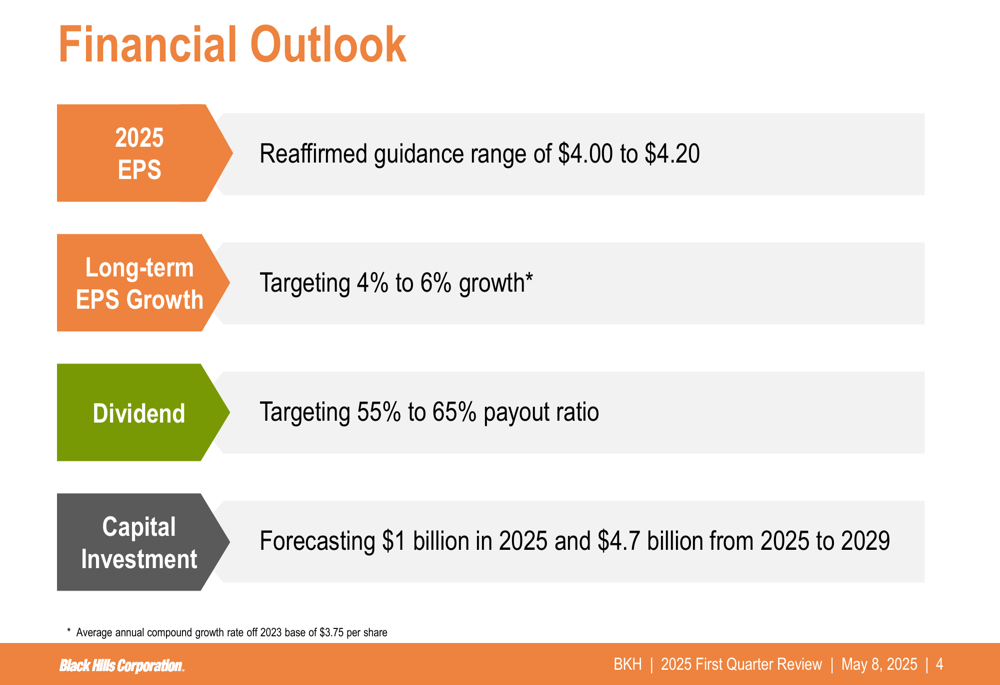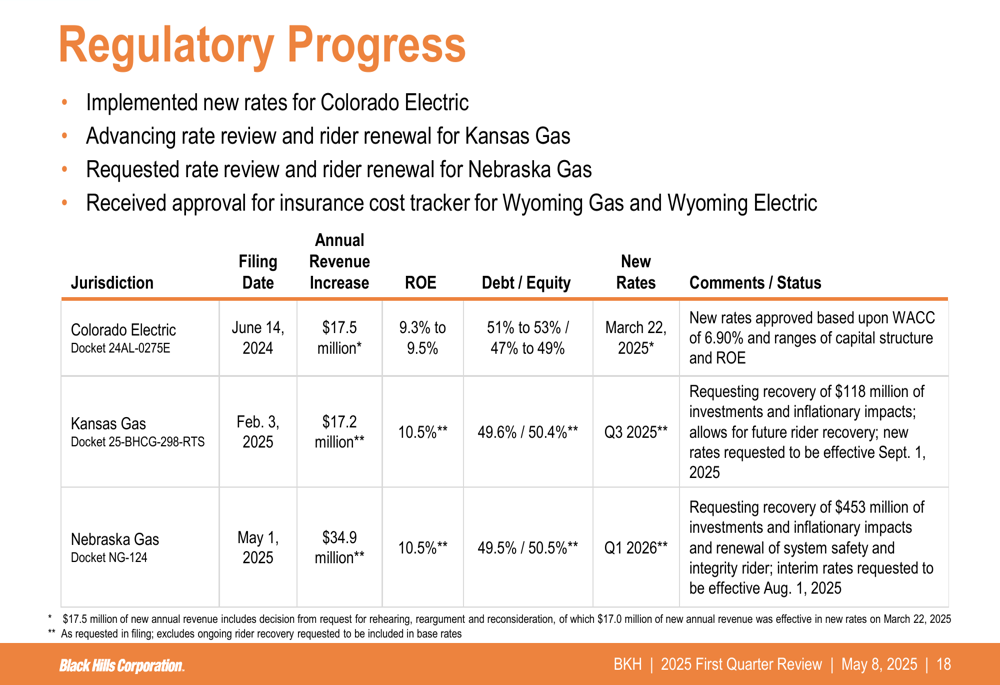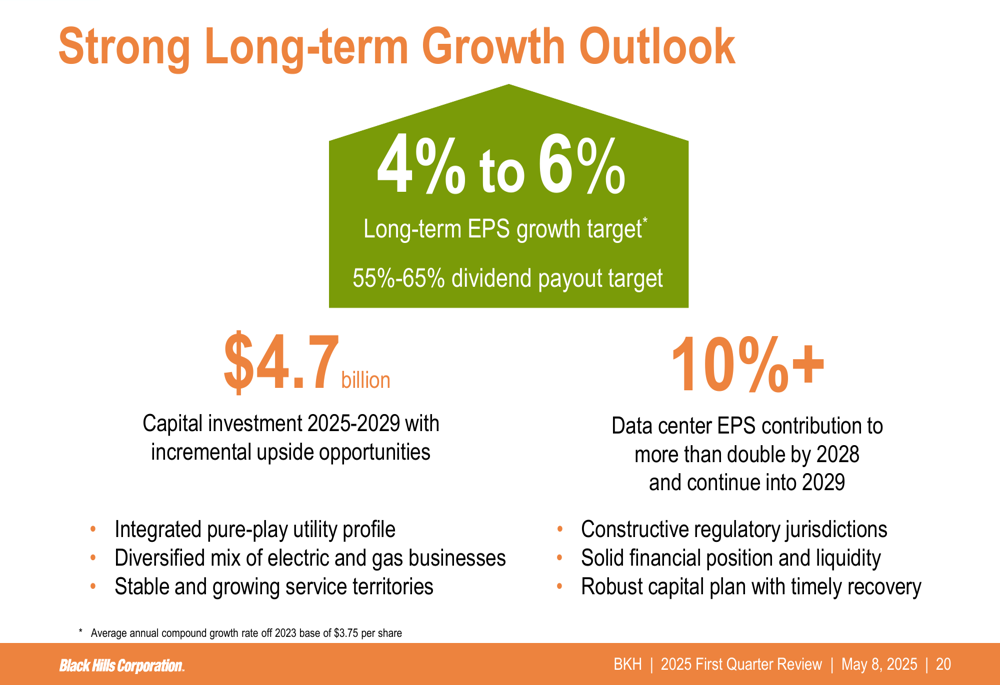Fed Governor Adriana Kugler to resign
Introduction & Market Context
Black Hills Corporation (NYSE:BKH) released its first quarter 2025 financial results on May 8, showing stable performance with earnings per share (EPS) holding steady at $1.87, matching the same period in 2024. The utility company reaffirmed its full-year EPS guidance range of $4.00 to $4.20 while highlighting significant progress on strategic initiatives focused on data center growth and transmission infrastructure.
The company’s stock closed at $61.75 on May 7, up 0.41% for the day, and trading within its 52-week range of $51.66 to $65.59. Black Hills continues to position itself as a growth-oriented utility with a balanced portfolio of electric and gas operations across multiple states.
Quarterly Performance Highlights
Black Hills reported Q1 2025 EPS of $1.87, unchanged from the same period last year. While the headline number remained flat, the underlying drivers showed notable shifts. Positive contributions from improved margins (+$0.29) and favorable weather conditions (+$0.11) were offset by higher operations and maintenance expenses (-$0.24) and increased financing costs (-$0.17).
As shown in the following chart of Q1 EPS drivers:

The company maintained its strong investment-grade credit ratings with Moody’s (Baa2, stable outlook) and S&P (BBB+, stable outlook). Available liquidity on the revolving credit facility stood at $687 million at quarter-end, providing financial flexibility for ongoing capital investments.
Black Hills’ capital structure improved from 65% to 60% between March 2024 and March 2025, reflecting the company’s commitment to maintaining a solid financial foundation. This aligns with management’s stated long-term funds from operations (FFO) to debt target of 14-15%.
Financial Outlook and Capital Plan
Black Hills reaffirmed its 2025 EPS guidance range of $4.00 to $4.20 and its long-term EPS growth target of 4% to 6%, based on a 2023 starting point of $3.75 per share. The company also maintained its dividend payout ratio target of 55% to 65%, supporting its impressive track record of 55 consecutive years of dividend increases.
The company’s financial outlook is summarized in the following slide:

Black Hills outlined a robust capital investment plan totaling $4.7 billion from 2025 to 2029, with $1 billion allocated for 2025 alone. These investments are primarily directed toward customer growth, safety and system integrity projects, replacement and modernization programs, and electric generation and transmission infrastructure.
The five-year capital investment forecast is illustrated in this chart:

The company’s dividend history demonstrates consistent growth, with a 4.5% compound annual growth rate (CAGR) from 2020 to 2025. The current annualized dividend rate stands at $2.70 per share, marking the 55th consecutive year of increases and the 83rd consecutive year of dividend payments.
Strategic Initiatives
Data center growth represents a significant opportunity for Black Hills, with the company projecting more than 1 gigawatt (GW) of data center demand within its service territories over the next decade. Management expects data center contributions to more than double to over 10% of EPS by 2028, driven by partnerships with major technology companies including Microsoft (NASDAQ:MSFT) (10+ years relationship) and Meta (NASDAQ:META) (starting in 2026).
The company highlighted its "Ready Wyoming" electric transmission initiative, a 260-mile, $350 million expansion project that remains on track for completion by year-end 2025. This strategic infrastructure investment will enhance system resiliency, expand access to power markets, and support economic growth, particularly for data centers in Wyoming.
The Ready Wyoming project status is detailed in the following slide:

In Colorado, Black Hills is advancing its Clean Energy Plan, which aims to reduce emissions by 80% by 2030. The plan includes adding 100 MW of utility-owned solar, 50 MW of utility-owned battery storage, and a 200 MW solar power purchase agreement. The company received Public Utility Commission approval in Q4 2024 and expects to place these new resources in service between 2027 and 2028.
For South Dakota, Black Hills is addressing resource needs with the addition of 99 MW of dispatchable natural gas generation (Lange II) scheduled for completion in the second half of 2026. The company requested a Certificate of Public Convenience and Necessity (CPCN) from the Wyoming Public Service Commission in Q1 2025 and anticipates approval in the second half of the year.
Regulatory Progress and Risk Management
Black Hills reported several regulatory achievements during the quarter. The company implemented new rates for Colorado Electric and is advancing rate reviews for Kansas Gas and Nebraska Gas. A summary of these regulatory proceedings is shown below:

The company also made progress on wildfire risk mitigation and management. Wyoming House Bill 192, which limits wildfire-related liability, was signed into law. Black Hills expects to formalize its Public Safety Power Shutoff (PSPS) program by mid-2025 and continues to implement its Wildfire Mitigation Plan, which includes risk-prioritized asset programs, line and pole inspections, and enhanced risk assessment.
Forward-Looking Statements
Looking ahead, Black Hills remains confident in its long-term growth strategy, targeting 4% to 6% EPS growth with a 55% to 65% dividend payout ratio. The company’s $4.7 billion capital investment plan for 2025-2029 provides visibility for sustained growth, with potential upside from incremental opportunities.
The company’s long-term outlook is summarized in this slide:

Management emphasized several factors supporting this outlook, including the company’s integrated pure-play utility profile, diversified mix of electric and gas businesses, stable and growing service territories, constructive regulatory jurisdictions, solid financial position, and robust capital plan with timely recovery mechanisms.
Black Hills’ strategic focus on data center growth, transmission expansion, and clean energy initiatives positions the company to capitalize on evolving market opportunities while maintaining its commitment to operational excellence and shareholder returns.
Full presentation:
This article was generated with the support of AI and reviewed by an editor. For more information see our T&C.
